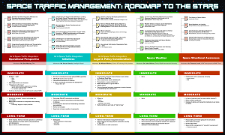Real-Time Atmosphere Density Estimation Approach for Space Traffic Management
Visit the panel Orbital Coordination: Part 2
Abstract
Spaceflight is entering a period of renaissance, with considerable change in the perception of humanity’s role in space. Recently, SpaceX and OneWeb have proposed mega satellite constellations in Low Earth Orbit (LEO) that are expected to increase the number of satellites in LEO multiple-fold. These constellations could revolutionize the telecommunication industry by providing complete global internet coverage. The economic gains of completely connecting rural areas and developing nations cannot be understated. However, the current space infrastructure is not capable of handling such a dramatic increase in the number of active satellites. Therefore, there is a critical need for new solutions to the problem of Space Traffic Management (STM) and Space Situational Awareness (SSA). Atmospheric drag remains the largest source of uncertainty in orbit prediction and conjunction assessments for collision probabilities in Low Earth Orbits. The uncertainty stems mainly from inaccurate models of the upper atmosphere. Recently, a new framework that uses an Unscented Kalman filter for sequential assimilation of data into a dynamic quasi-physical reduced order model has been developed the authors. The framework provides a transformative technology for real-time global state update of the upper atmosphere that will facilitate STM and SSA. In this work, we present a demonstration of the technology using Two-Line-Elements (TLE) data for real-time estimation of atmospheric density.
This paper has been withdrawn.
Feb 26th, 3:45 PM
Real-Time Atmosphere Density Estimation Approach for Space Traffic Management
Bass Auditorium
Spaceflight is entering a period of renaissance, with considerable change in the perception of humanity’s role in space. Recently, SpaceX and OneWeb have proposed mega satellite constellations in Low Earth Orbit (LEO) that are expected to increase the number of satellites in LEO multiple-fold. These constellations could revolutionize the telecommunication industry by providing complete global internet coverage. The economic gains of completely connecting rural areas and developing nations cannot be understated. However, the current space infrastructure is not capable of handling such a dramatic increase in the number of active satellites. Therefore, there is a critical need for new solutions to the problem of Space Traffic Management (STM) and Space Situational Awareness (SSA). Atmospheric drag remains the largest source of uncertainty in orbit prediction and conjunction assessments for collision probabilities in Low Earth Orbits. The uncertainty stems mainly from inaccurate models of the upper atmosphere. Recently, a new framework that uses an Unscented Kalman filter for sequential assimilation of data into a dynamic quasi-physical reduced order model has been developed the authors. The framework provides a transformative technology for real-time global state update of the upper atmosphere that will facilitate STM and SSA. In this work, we present a demonstration of the technology using Two-Line-Elements (TLE) data for real-time estimation of atmospheric density.







